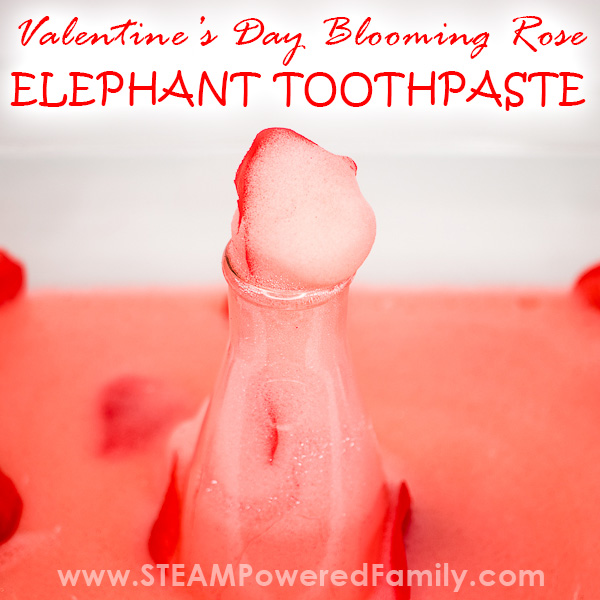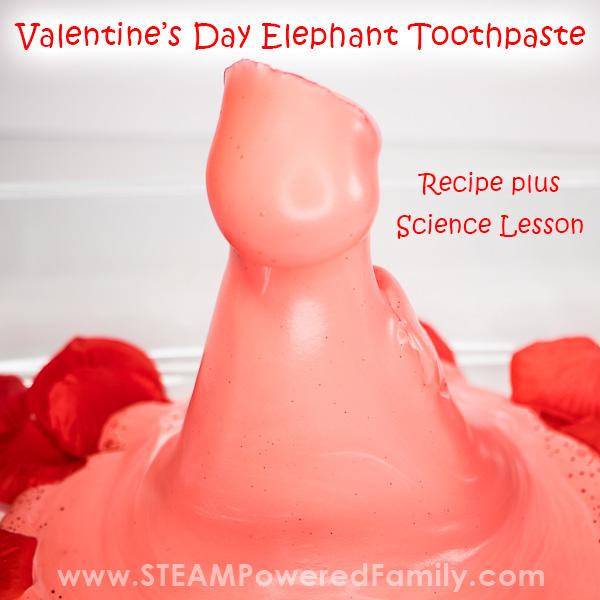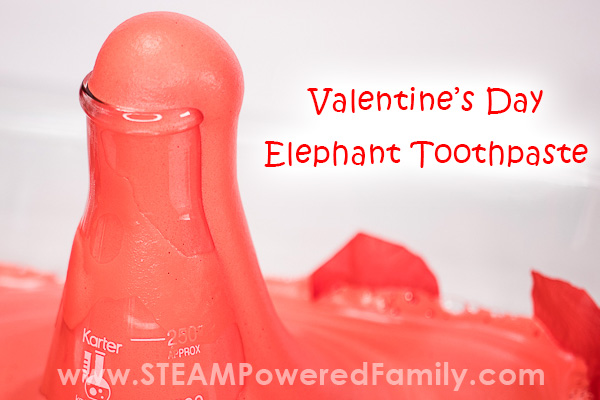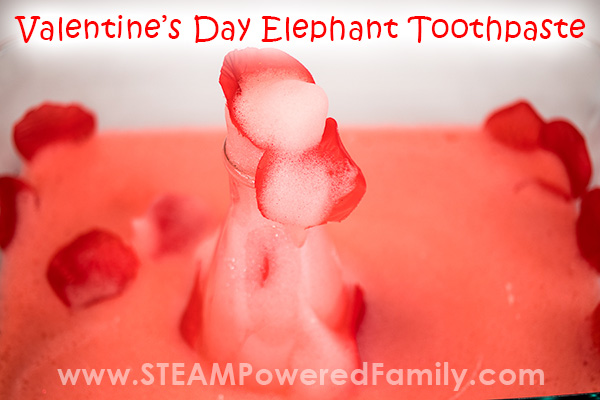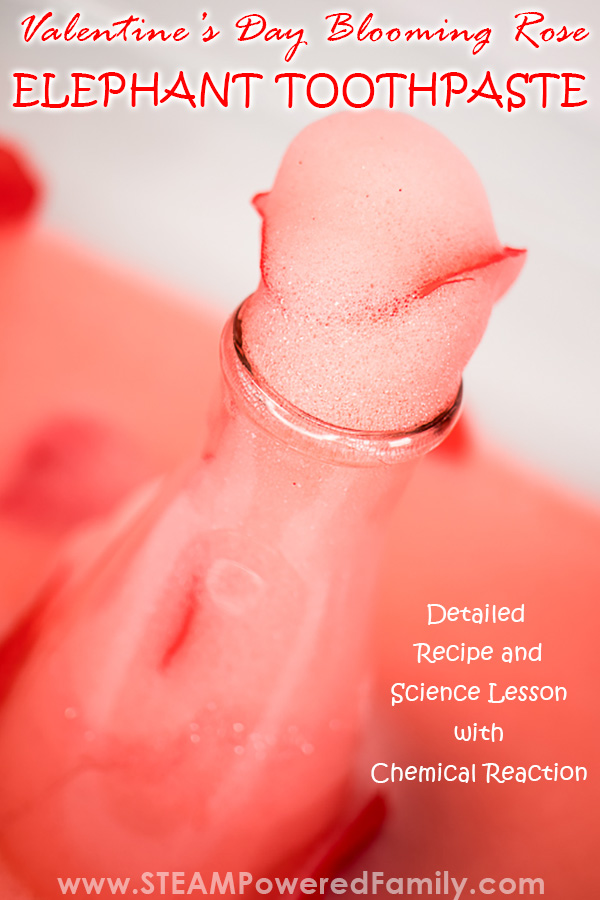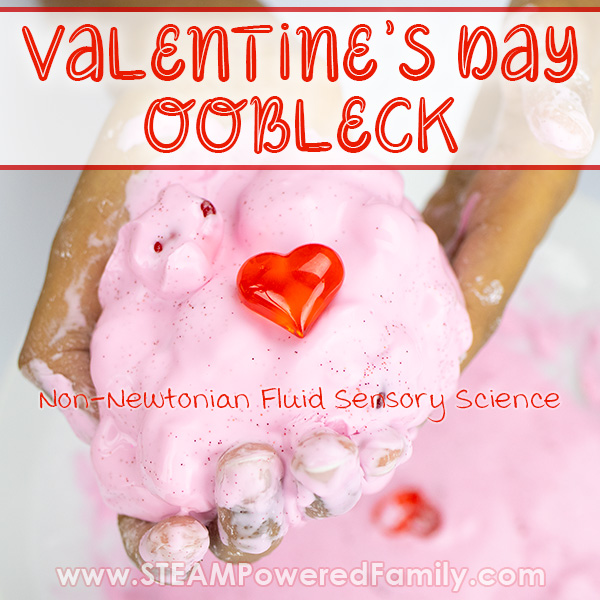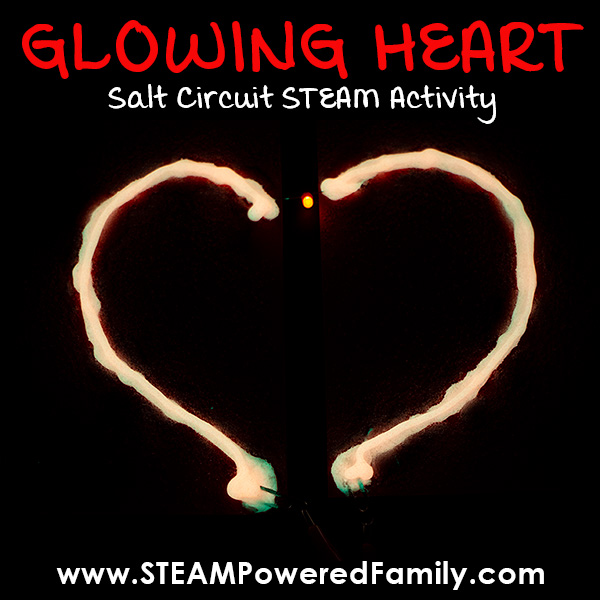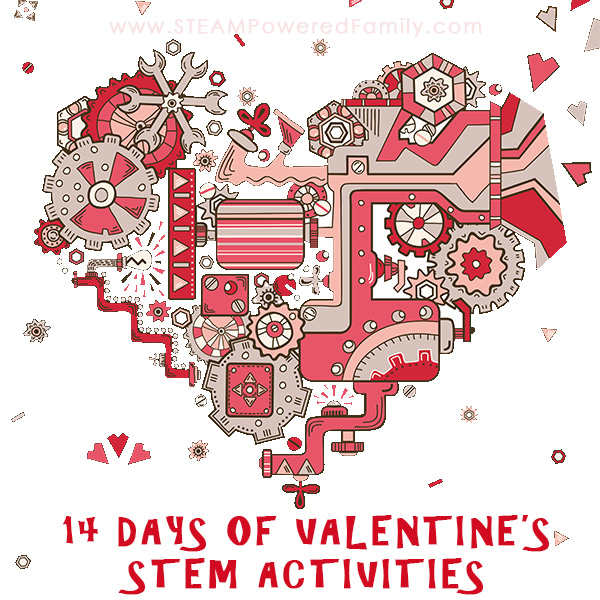Blooming Roses Elephant Toothpaste
We love the Elephant Toothpaste experiment. It is a simple, but wow worthy, science lab, and today we gave it a love filled, Valentine’s Day twist. We weren’t sure how this experiment would turn out, but the results of our Blooming Roses Elephant Toothpaste was even better than we expected!
Valentine’s Day Elephant Toothpaste
Disclaimer: This article may contain commission or affiliate links. As an Amazon Influencer I earn from qualifying purchases.
Not seeing our videos? Turn off any adblockers to ensure our video feed can be seen. Or visit our YouTube channel to see if the video has been uploaded there. We are slowly uploading our archives. Thanks!
With Valentine’s Day coming up I wanted to create some unique and innovative hands on activities and experiments that would inspire my kids and provide some memorable learning opportunities.
But coming up with Valentine’s Day ideas for kids is not always easy. Especially as they get older. That is why I love a good Valentine’s Day themed science experiment.
One activity we really enjoyed last year was making Elephant Toothpaste at home.
I am sure many of you are looking at the screen wondering what the heck I am talking about. I can hear the questions now… So let’s answer them!
What is Elephant Toothpaste?
Elephant toothpaste is a fantastic foamy science experiment. At science centers they often do extreme examples of Elephant Toothpaste that shoot to the ceiling in massive geysers, but there is also a safe, smaller version we can do at home.
When done in a beaker or bottle that narrows at the top, it oozes out like a great big tube of toothpaste. Perfectly sized for an elephant!
Why is Elephant Toothpaste called Elephant Toothpaste?
The Elephant Toothpaste experiment is usually done in a beaker. When done in a beaker or bottle that narrows at the top, the reaction oozes out like a great big tube of toothpaste. The chemical reaction produces a foamy ooze, that looks a lot like toothpaste being squeezed out of the tube. But in this reaction it is much, much bigger than at tube of toothpaste. It is perfectly sized for an elephant!
Is Elephant Toothpaste Safe to Touch?
This Elephant Toothpaste recipe is safe to touch and do at home. In fact touching it with your fingers or hands is part of how students will explore the exothermic reaction, as the foam warms.
This experiment may be called Elephant Toothpaste, but this is not toothpaste and should NEVER be ingested or tasted. Safe to touch, not to taste! Ensure proper adult supervision is always provided when doing any science experiments.
What is Elephant Toothpaste Good For? What Lessons Does It Teach?
Elephant Toothpaste packs huge wow factor with the kids. It also provides a sensory experience while teaching kids important scientific principles and vocabulary, such as:
- Chemical Reactions
- Catalyst
- Surface tension
- Exothermic Reactions
- Temperature
- Liquid/Gas (states of matter)
- Mixture
- Density (with our special Valentine’s Day version!)
Valentine’s Day Science Experiment
So now you know all about Elephant Toothpaste, it’s time to explore our GORGEOUS Valentine’s Day themed Elephant Toothpaste. Elephants, and students, will be feeling all the wonder and love with this incredible chemical reaction!
In this experiment, we are harnessing the energy of the reaction to create a blooming effect with rose petals. The result is beautiful and really exciting as students watch the petals emerge and open before gently falling down the side of the beaker in a cascade of coloured foam.
Check out the Video
If you can’t see the video, please turn off your adblockers as they also block our video feed.
Valentine’s Day Elephant Toothpaste Supplies
250mL Glass Erlenmeyer Flask or an empty pop or water bottle works too
Dry yeast
Warm water
Liquid dish soap
3% hydrogen peroxide*
Red food coloring
Rose petals (real or you can find reusable ones at the dollar store)
Glitter (totally optional, we recommend biodegradable glitter if you decide to use it)
Measuring cups
Measuring spoons
Safety glasses, lab coat (optional)
Towel (for cleaning up fingers after touching the experiment)
Large tub or tray (something with a lip to catch the reaction)
Funnel (optional – can help kids with pouring)
Infrared non-contact thermometer (optional, helps with measuring the exothermic reaction)
*Higher percentage concentration hydrogen peroxide are dangerous and can cause skin irritation. Ensure you are using 3% with your kids in this experiment.
Elephant Toothpaste Recipe
The basic recipe to make Elephant Toothpaste is:
1 Tbsp Yeast
1/4 cup warm water
150mL 3% Hydrogen Peroxide
1 Tbsp dish soap
5 – 10 drops food coloring
To this recipe we added some glitter and our rose petals to create our Valentine’s Day version.
1 Tsp Biodegradable Glitter
4 or 5 Rose Petals
Directions
Pick a place to do this experiment that is easy to clean up. If you do this in a nice big, high lipped tray that should contain most of foam, but in my experience kids love to play and touch the foam, so things can get messy quickly. Having a towel on hand is helpful if you know your kids are going to want to touch and explore.
Start by mixing 1 tablespoon of yeast with 1/4 cup warm water in cup to create the first mixture. Let it sit for about 30 seconds while you prep the beaker.
Into the beaker flask add 150 mL of Hydrogen Peroxide, a tablespoon of dish soap, and about 5 – 10 drops of food coloring (use less if your food coloring is a gel). If using glitter, add that too. Give it a swirl or a stir to mix it all together.
Then fold the petals in half, one at a time, and slip them into the beaker. Now I know the temptation will be to add LOTS of petals. But trust me, we tried it, and any more than 4 or 5 petals and they got stuck in the neck of the flask and didn’t bloom. So less is more!
If you are taking temperature readings of the reaction, take a temperature reading and record it of each of the liquids now.
Now pour the yeast mixture into the hydrogen peroxide mixture.
Watch the reaction!
As the reaction takes place, foam will ooze out of the top of the flask. As it does this, it will bring petals up, and they will appear to bloom out of the top of the flask. The petals will open, then gently fall down the side of the flask. The best part is that this is a long reaction. So keep watching, and you will get rewarded with more petals blooming.
If you are doing temperatures, make sure you take a temperature read and record those results during the reaction too.
How To Clean Up Elephant Toothpaste
This experiment is super easy to clean up. Simply rinse and wash up in the sink (this is why we recommend biodegradable glitter, to avoid microplastics getting into the water system).
If you are using real rose petals, they can go into the compost bin. If you have reusable petals, simply rinse and dry them so they are ready for the next experiment.
Elephant Toothpaste Chemical Reaction
The main reactor in this experiment is 3% Hydrogen Peroxide (chemical formula H2O2), which is used in first aid as an antiseptic. Normally it comes in a dark bottle because H2O2 breaks down in light, turning into oxygen (O2) and water (H2O). Normally this reaction happens very slowly, but we can speed it up with a little science!
Yeast, which we use to make bread, is an organism that contains a special chemical called catalase that can act as a catalyst to help break down hydrogen peroxide. This means that if you mix yeast with hydrogen peroxide, the hydrogen peroxide will rapidly break down into liquid water and oxygen gas. During this process energy is also released in the form of heat, which is known as an exothermic reaction.
The chemical reaction for Elephant Toothpaste:
2 H2O2 (aq) → 2 H2O (l) + O2 (g)
Those gas bubbles would normally pop and disappear, but by adding a bit of dish soap, we can trap those bubbles thanks to an increase in surface tension. We explore this scientific concept in our Magic Milk experiment. This means the foam is simply soap, oxygen and water. Perfectly safe to touch and explore!
In fact, we did this Valentine’s Day Elephant Toothpaste once without dish soap to see what would happen. The result was still very bubbly, and our petals still erupted, but the toothpaste was more bubbles, not foamy, and it didn’t have quite the same energy. With the dish soap the foamy tower out of the top of the beaker would really go high, then ooze over. Without dish soap, it didn’t get as high before cascading down the sides of the flask.
Our Valentine’s Day version, also explores how the energy of the reaction lifts up the petals, carrying them out of the flask, once released from the neck they unfurl and appear to bloom.
The result is a spectacular eruption of foam known as Elephant Toothpaste.
Extension Activities
There are a few things you can do to dig deeper into this reaction:
- The petals lifted easily, but what about other items? Can you get the reaction to lift up other items? Why do some items lift and others don’t lift?
- Use an infrared no touch thermometer to measure the exothermic reaction and see what variable changes you can make that affect the temperature changes.
- Alter the ratio of yeast to hydrogen peroxide. What effect does it have on the reaction?
- Visit your local science centre and ask when they will be doing their next Elephant Toothpaste demonstration. They use a different reaction that produces spectacular results!
- Only do this next extension with responsible middle or high school students, and under direct adult supervision – Visit the hair supply store and get 6% or higher hydrogen peroxide. How does the higher concentration hydrogen peroxide change the results? (Hint… bigger and messier!)
It might not be a traditional blooming rose for Valentine’s Day, but we know this version will be a big hit with students!
More Valentine’s Day For Kids

Blooming Rose Elephant Toothpaste – Valentine’s Day Science
A mesmerizing twist on the classic Elephant Toothpaste experiment, this Blooming Roses Elephant Toothpaste is perfect for Valentine's Day.
Supplies
- 1 tbsp yeast fast acting
- 1/4 cup warm water
- 150 mL 3% Hydrogen Peroxide
- 1 tbsp dish soap
- 5 – 10 drops food colouring use less if using gel food colouring
- 5 petals real or fake rose petals
Instructions
-
Gather supplies and set up in an area that will be easy to clean
-
Start by mixing 1 tablespoon of yeast with 1/4 cup warm water in cup. Let it sit for about 30 seconds while you prep the beaker.
-
Into the beaker flask add 150 mL of Hydrogen Peroxide, a tablespoon of dish soap, and about 5 – 10 drops of red food colouring. If using glitter, add that too. Mix it all together.
-
Fold the petals in half, one at a time, and slip them into the beaker. Do this with about 5 petals.
-
Now pour the yeast mixture into the hydrogen peroxide mixture.
-
Watch the reaction and the petals bloom!


